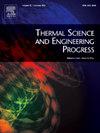基于改进图像修复算法的热辐射图像在运动员爆炸力模拟中的应用:热损失分析
IF 5.1
3区 工程技术
Q2 ENERGY & FUELS
引用次数: 0
摘要
本文章由计算机程序翻译,如有差异,请以英文原文为准。
Thermal radiation image based on improved image restoration algorithm in athlete explosive power simulation: Heat loss analysis
The explosive power of Sanda is closely related to the rapid release of energy in the athlete’s body, and the thermal radiation image can effectively capture the change of body surface temperature during the athlete’s movement. In this paper, an improved image restoration algorithm is developed to improve the application effect of thermal radiation image in Sanda explosive force simulation. In this paper, a high sensitivity thermal imager was used to collect thermal radiation images of athletes in a standardized Sanda training environment. After preprocessing the acquired thermal radiation image, the improved image recovery algorithm based on deep learning can effectively identify and recover the details of the image by learning a large amount of thermal radiation image data, and suppress the noise interference. After applying the improved image recovery algorithm to process the thermal radiation image, the surface temperature change data is extracted by image analysis technology. Based on the biomechanical model of sanda movement, the heat loss of athletes in different explosive movements is analyzed. By comparing the results with the traditional image restoration algorithm, the advantages of the improved algorithm in improving the quality of thermal radiation image and the accuracy of heat loss analysis are verified. The results show that the improved image restoration algorithm has significant advantages in processing thermal radiation images. Compared with the traditional algorithm, the image processed by the improved algorithm has obvious improvement in detail retention and noise suppression. The improved algorithm can recover the detailed information in the thermal radiation image more accurately. In different explosive movements of Sanda athletes, the change of body surface temperature is closely related to the complexity of movements and force output. These changes can be observed more clearly through the improved thermal radiation images processed by the algorithm, which provides a new perspective for the training and evaluation of Sanda athletes.
求助全文
通过发布文献求助,成功后即可免费获取论文全文。
去求助
来源期刊

Thermal Science and Engineering Progress
Chemical Engineering-Fluid Flow and Transfer Processes
CiteScore
7.20
自引率
10.40%
发文量
327
审稿时长
41 days
期刊介绍:
Thermal Science and Engineering Progress (TSEP) publishes original, high-quality research articles that span activities ranging from fundamental scientific research and discussion of the more controversial thermodynamic theories, to developments in thermal engineering that are in many instances examples of the way scientists and engineers are addressing the challenges facing a growing population – smart cities and global warming – maximising thermodynamic efficiencies and minimising all heat losses. It is intended that these will be of current relevance and interest to industry, academia and other practitioners. It is evident that many specialised journals in thermal and, to some extent, in fluid disciplines tend to focus on topics that can be classified as fundamental in nature, or are ‘applied’ and near-market. Thermal Science and Engineering Progress will bridge the gap between these two areas, allowing authors to make an easy choice, should they or a journal editor feel that their papers are ‘out of scope’ when considering other journals. The range of topics covered by Thermal Science and Engineering Progress addresses the rapid rate of development being made in thermal transfer processes as they affect traditional fields, and important growth in the topical research areas of aerospace, thermal biological and medical systems, electronics and nano-technologies, renewable energy systems, food production (including agriculture), and the need to minimise man-made thermal impacts on climate change. Review articles on appropriate topics for TSEP are encouraged, although until TSEP is fully established, these will be limited in number. Before submitting such articles, please contact one of the Editors, or a member of the Editorial Advisory Board with an outline of your proposal and your expertise in the area of your review.
 求助内容:
求助内容: 应助结果提醒方式:
应助结果提醒方式:


